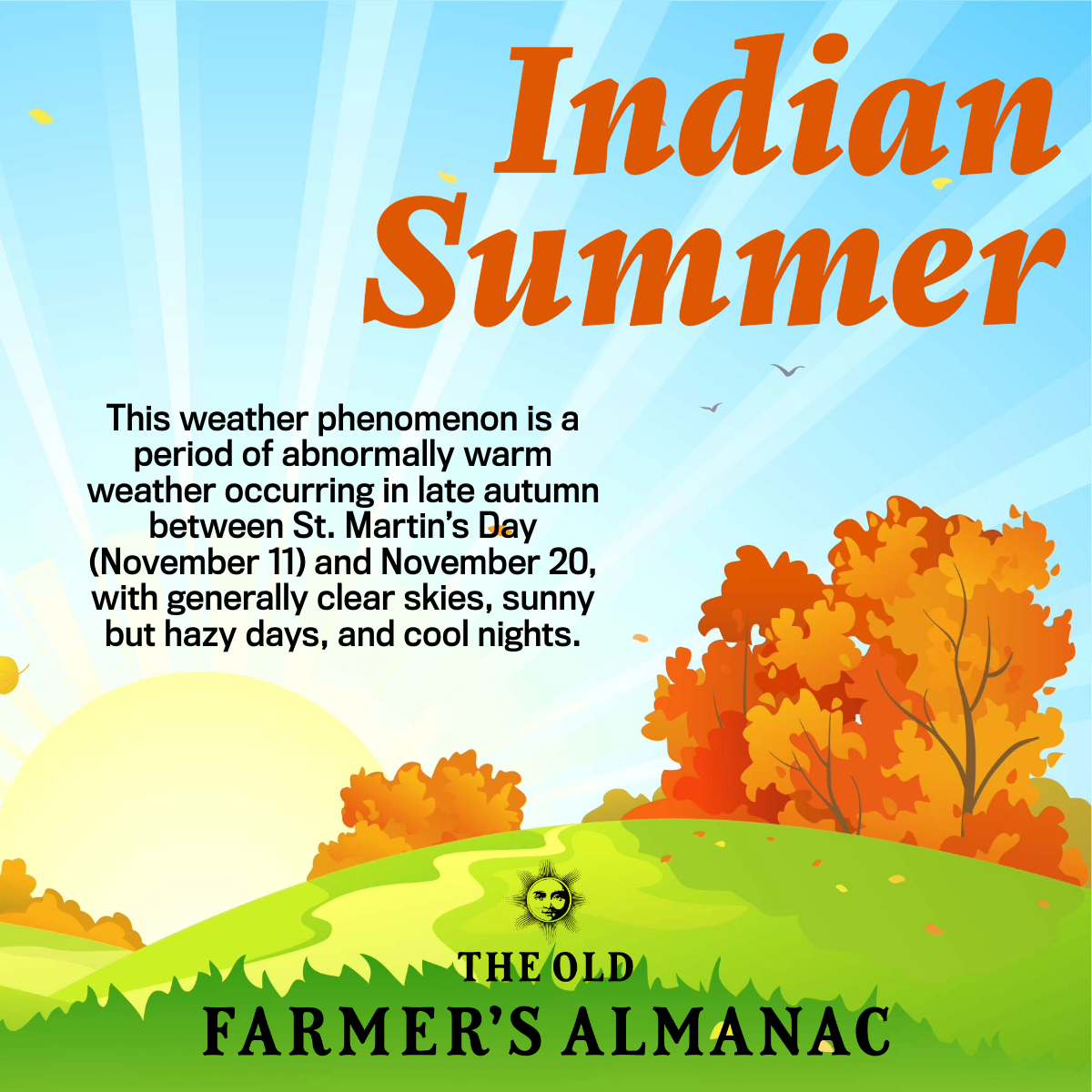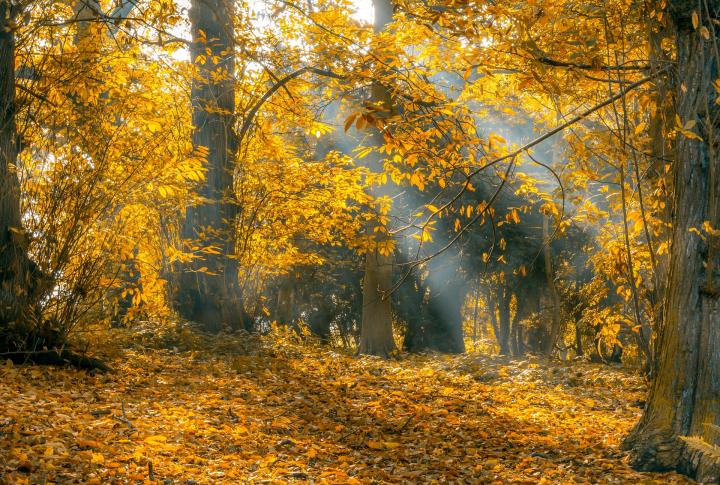I have noticed there is always unseasonably warm weather around Halloween time. Yes, we are experiencing the so called Indian Summer. What is an Indian Summer or Second Summer?
The term “Indian Summer” has been around for centuries. What is an Indian Summer or Second Summer? Where did this term originate, and what is its meaning today? Learn more.
For over two centuries, The Old Farmer’s Almanac has gone by the adage: “If All Saints’ (November 1) brings out winter, St. Martin’s brings out Indian summer.”
“Indian Summer” is not the best terminology, given the history of the term “Indian” in North America. The weather phenomenon is best described using the term that Europeans and British still use: St. Martin’s Summer. This references St. Martin’s Day—November 11—the official start of these unusually late warm spells. Another popular term used by the American Meteorological Society is “Second Summer,” which is indeed appropriately descriptive.
In England, Shakespeare used the expression “All Halloween Summer.” Other old terms include the unfortunate “Old Wives’ Summer” and, poetically, “Halcyon Days.”
Definition of Indian Summer, Second Summer
Here are several criteria for this weather phenomenon, according to The Old Farmer’s Almanac.
It’s a period of abnormally warm weather occurring in late autumn between St. Martin’s Day (November 11) and November 20, with generally clear skies, sunny but hazy days, and cool nights. The time of occurrence is important: It occurs after at least one good killing frost but also be before the first snowfall; preferably a substantial period of normally cool weather must precede this warm spell. As well as being warm, the atmosphere is hazy or smoky, there is no wind, the barometer is standing high, and the nights are clear and chilly. A moving, cool, shallow polar air mass is converting into a deep, warm, stagnant anticyclone (high pressure) system, which has the effect of causing the haze and large swing in temperature between day and night.
Given above criteria, this weather phenomenon does not occur every year and it occurs more than once some years. We rather enjoy this description written by Sandy Griswold for the Omaha Sunday World-Herald in November 1922:
I am enabled to say, however, that the characteristics of the season, when it appears in all its glory, are a mild and genial temperature, gentle southwestern breezes, unusual brightness of the sun, extreme brilliancy of the moon, a clear, blue sky; sometimes half hidden by a veil of gray haze; daybreaks redder than the splotch on the blackbird’s wing, and sunsets laden with golden fleeces, the wooded valleys aglow with the fires of richly tinted leaves, still clinging to the listless limbs, or lying where they have fallen….
What is the Origin of Indian Summer?
So where did this term come from? The origin is not certain, but dates back as far back as 1778 in Letters From an American Farmer by the French-American soldier turned farmer Michel-Guillaume-Jean de Crèvecoeur:
“Then a severe frost succeeds which prepares it to receive the voluminous coat of snow which is soon to follow; though it is often preceded by a short interval of smoke and mildness, called the Indian Summer.”
There are many theories. Here are a few of the more plausible ones:
Some say it comes from the Narragansett people located in what is now the northeastern United States, who believed that the condition was caused by a warm wind sent from the court of their southwestern god, Cautantowwit (“great spirit”). Another theory is that Native Americans would routinely use this brief period of warm fall weather as an opportunity to increase winter stores. November is the time to get one’s last harvest in before winter truly shows its head, so a short period of warm weather would be of note around this time. A third theory suggests that early American settlers mistook the sight of sun rays through the hazy autumn air for Native American campfires, resulting in the name “Indian summer.”
The term “Indian Summer” has been around for centuries. What is an Indian Summer or Second Summer? Where did this term originate, and what is its meaning today? Learn more.
For over two centuries, The Old Farmer’s Almanac has gone by the adage: “If All Saints’ (November 1) brings out winter, St. Martin’s brings out Indian summer.”
“Indian Summer” is not the best terminology, given the history of the term “Indian” in North America. The weather phenomenon is best described using the term that Europeans and British still use: St. Martin’s Summer. This references St. Martin’s Day—November 11—the official start of these unusually late warm spells. Another popular term used by the American Meteorological Society is “Second Summer,” which is indeed appropriately descriptive.
In England, Shakespeare used the expression “All Halloween Summer.” Other old terms include the unfortunate “Old Wives’ Summer” and, poetically, “Halcyon Days.”

Definition of Indian Summer, Second SummerHere are several criteria for this weather phenomenon, according to The Old Farmer’s Almanac.
It’s a period of abnormally warm weather occurring in late autumn between St. Martin’s Day (November 11) and November 20, with generally clear skies, sunny but hazy days, and cool nights. The time of occurrence is important: It occurs after at least one good killing frost but also be before the first snowfall; preferably a substantial period of normally cool weather must precede this warm spell. As well as being warm, the atmosphere is hazy or smoky, there is no wind, the barometer is standing high, and the nights are clear and chilly. A moving, cool, shallow polar air mass is converting into a deep, warm, stagnant anticyclone (high pressure) system, which has the effect of causing the haze and large swing in temperature between day and night.Given above criteria, this weather phenomenon does not occur every year and it occurs more than once some years. We rather enjoy this description written by Sandy Griswold for the Omaha Sunday World-Herald in November 1922:
I am enabled to say, however, that the characteristics of the season, when it appears in all its glory, are a mild and genial temperature, gentle southwestern breezes, unusual brightness of the sun, extreme brilliancy of the moon, a clear, blue sky; sometimes half hidden by a veil of gray haze; daybreaks redder than the splotch on the blackbird’s wing, and sunsets laden with golden fleeces, the wooded valleys aglow with the fires of richly tinted leaves, still clinging to the listless limbs, or lying where they have fallen….

What is the Origin of Indian Summer?So where did this term come from? The origin is not certain, but dates back as far back as 1778 in Letters From an American Farmer by the French-American soldier turned farmer Michel-Guillaume-Jean de Crèvecoeur:
“Then a severe frost succeeds which prepares it to receive the voluminous coat of snow which is soon to follow; though it is often preceded by a short interval of smoke and mildness, called the Indian Summer.”
There are many theories. Here are a few of the more plausible ones:
Some say it comes from the Narragansett people located in what is now the northeastern United States, who believed that the condition was caused by a warm wind sent from the court of their southwestern god, Cautantowwit (“great spirit”). Another theory is that Native Americans would routinely use this brief period of warm fall weather as an opportunity to increase winter stores. November is the time to get one’s last harvest in before winter truly shows its head, so a short period of warm weather would be of note around this time. A third theory suggests that early American settlers mistook the sight of sun rays through the hazy autumn air for Native American campfires, resulting in the name “Indian summer.”对吗?
你太神奇了,佩服
我都不记得这个photo credit, 直接全文搬
特意找到上一次看的那一篇,Wiki 上的干巴巴的
其一 自古逢秋悲寂寥,我言秋日胜春朝。 晴空一排云上,便引诗情到碧霄。 其二 山明水净夜来霜,数树深红出浅黄。 试上高楼清入骨,岂如春色嗾人狂